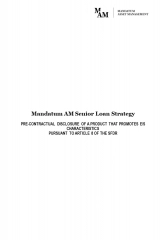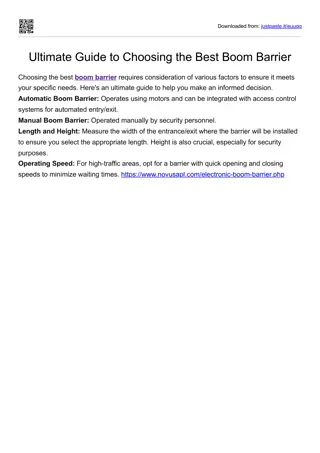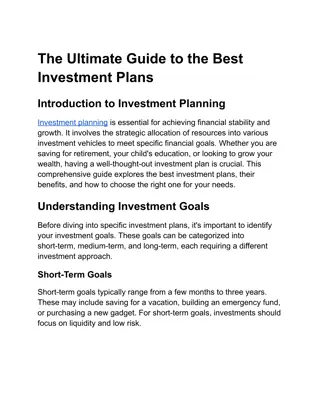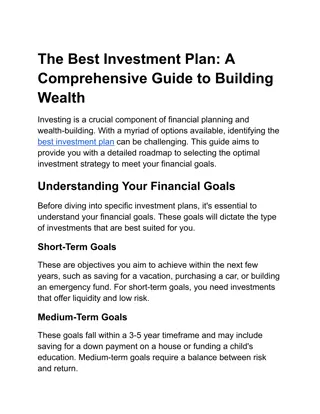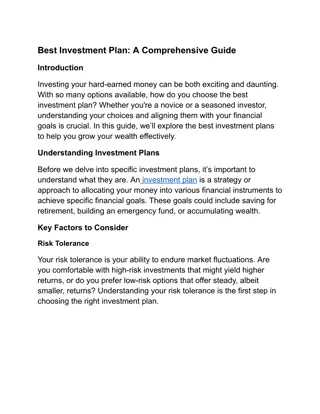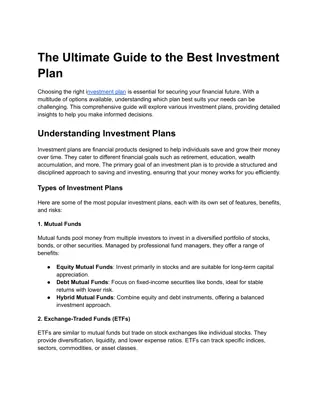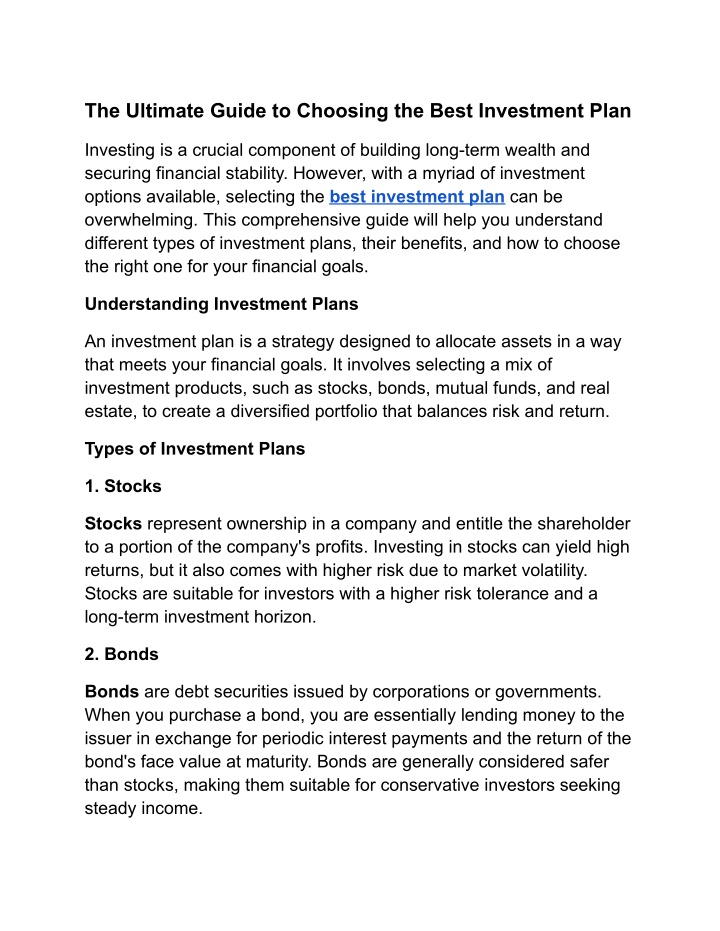
The Ultimate Guide to Choosing the Best Investment Plan
Investing is a crucial component of building long-term wealth and securing financial stability. However, with a myriad of investment options available, selecting the best investment plan can be overwhelming. This comprehensive guide will help you understand different types of investment plans, their benefits, and how to choose the right one for your financial goals.
Uploaded on | 5 Views
Download Presentation

Please find below an Image/Link to download the presentation.
The content on the website is provided AS IS for your information and personal use only. It may not be sold, licensed, or shared on other websites without obtaining consent from the author. If you encounter any issues during the download, it is possible that the publisher has removed the file from their server.
You are allowed to download the files provided on this website for personal or commercial use, subject to the condition that they are used lawfully. All files are the property of their respective owners.
The content on the website is provided AS IS for your information and personal use only. It may not be sold, licensed, or shared on other websites without obtaining consent from the author.
E N D
Presentation Transcript
The Ultimate Guide to Choosing the Best Investment Plan Investing is a crucial component of building long-term wealth and securing financial stability. However, with a myriad of investment options available, selecting the best investment plan can be overwhelming. This comprehensive guide will help you understand different types of investment plans, their benefits, and how to choose the right one for your financial goals. Understanding Investment Plans An investment plan is a strategy designed to allocate assets in a way that meets your financial goals. It involves selecting a mix of investment products, such as stocks, bonds, mutual funds, and real estate, to create a diversified portfolio that balances risk and return. Types of Investment Plans 1. Stocks Stocks represent ownership in a company and entitle the shareholder to a portion of the company's profits. Investing in stocks can yield high returns, but it also comes with higher risk due to market volatility. Stocks are suitable for investors with a higher risk tolerance and a long-term investment horizon. 2. Bonds Bonds are debt securities issued by corporations or governments. When you purchase a bond, you are essentially lending money to the issuer in exchange for periodic interest payments and the return of the bond's face value at maturity. Bonds are generally considered safer than stocks, making them suitable for conservative investors seeking steady income.
3. Mutual Funds Mutual funds pool money from multiple investors to invest in a diversified portfolio of stocks, bonds, or other securities. They are managed by professional fund managers, which can be beneficial for investors who prefer a hands-off approach. Mutual funds offer diversification and are suitable for investors with various risk appetites. 4. Exchange-Traded Funds (ETFs) ETFs are similar to mutual funds but trade on stock exchanges like individual stocks. They offer diversification and lower expense ratios compared to mutual funds. ETFs are suitable for investors looking for a flexible and cost-effective investment option. 5. Real Estate Real estate investing involves purchasing property to generate rental income or to sell at a higher price in the future. Real estate can provide steady income and long-term capital appreciation. It is suitable for investors looking for tangible assets and willing to manage property-related responsibilities. 6. Retirement Accounts Retirement accounts such as 401(k)s and IRAs offer tax advantages to encourage long-term savings. These accounts can hold a variety of investments, including stocks, bonds, and mutual funds. Retirement accounts are ideal for individuals planning for their financial future and seeking tax benefits. 7. Index Funds Index funds are a type of mutual fund or ETF designed to replicate the performance of a specific market index, such as the S&P 500.
They offer broad market exposure, low fees, and consistent returns, making them suitable for passive investors. 8. Certificates of Deposit (CDs) CDs are time deposits offered by banks with a fixed interest rate and maturity date. They are low-risk investments that provide guaranteed returns. CDs are ideal for conservative investors seeking safe and predictable income. Key Factors to Consider When Choosing an Investment Plan Selecting the best investment plan involves evaluating several critical factors to ensure it aligns with your financial goals and risk tolerance: 1. Investment Goals Identify your short-term and long-term financial goals. Whether you are saving for retirement, a home, education, or other objectives, your investment plan should be tailored to meet these specific goals. 2. Risk Tolerance Assess your risk tolerance to determine the level of investment risk you are comfortable with. Higher-risk investments, like stocks, offer the potential for higher returns, while lower-risk investments, like bonds, provide more stability. 3. Time Horizon Consider your investment time horizon, which is the length of time you plan to hold your investments. Longer time horizons allow for greater risk-taking and the potential for higher returns, while shorter time horizons necessitate more conservative investments.
4. Diversification Diversification involves spreading your investments across different asset classes to reduce risk. A well-diversified portfolio can help balance potential returns and minimize the impact of poor-performing investments. 5. Fees and Expenses Evaluate the fees and expenses associated with different investment options. Lower fees can significantly enhance your investment returns over time. Be aware of management fees, trading costs, and other charges. 6. Liquidity Consider the liquidity of your investments, or how easily they can be converted to cash. Highly liquid investments, like stocks and ETFs, can be quickly sold, while less liquid investments, like real estate, may take longer to sell. 7. Tax Implications Understand the tax implications of your investments. Certain accounts, like retirement accounts, offer tax advantages that can help grow your wealth more efficiently. How to Develop an Investment Plan 1. Set Clear Goals Define your financial goals and the time frame for achieving them. This will help guide your investment strategy and asset allocation.
2. Determine Your Risk Tolerance Use online tools or consult with a financial advisor to assess your risk tolerance. This will help you choose investments that align with your comfort level. 3. Choose an Asset Allocation Decide on the appropriate mix of asset classes (e.g., stocks, bonds, real estate) based on your goals, risk tolerance, and time horizon. A diversified portfolio can help manage risk and enhance returns. 4. Select Investments Research and select specific investments within each asset class. Consider factors such as performance history, fees, and management style. 5. Monitor and Adjust Regularly review your investment plan to ensure it remains aligned with your goals. Make adjustments as needed based on changes in your financial situation, market conditions, and investment performance. Benefits of a Well-Structured Investment Plan A well-structured investment plan offers several key benefits: 1. Financial Security Investing can help you build wealth and achieve financial security over time, ensuring you can meet your financial goals and handle unexpected expenses.
2. Wealth Growth By strategically investing in a diversified portfolio, you can grow your wealth and increase your net worth over the long term. 3. Income Generation Certain investments, such as bonds and real estate, can provide a steady stream of income, supplementing your regular earnings. 4. Inflation Protection Investing can help protect your savings from inflation by generating returns that outpace the rising cost of living. 5. Retirement Planning A solid investment plan is essential for building a retirement nest egg, ensuring you have sufficient funds to maintain your lifestyle in retirement. Conclusion Choosing the best investment plan is a critical step in achieving your financial goals and securing your future. By understanding the different types of investment options, evaluating key factors, and developing a well-structured plan, you can make informed decisions that enhance your financial well-being.

